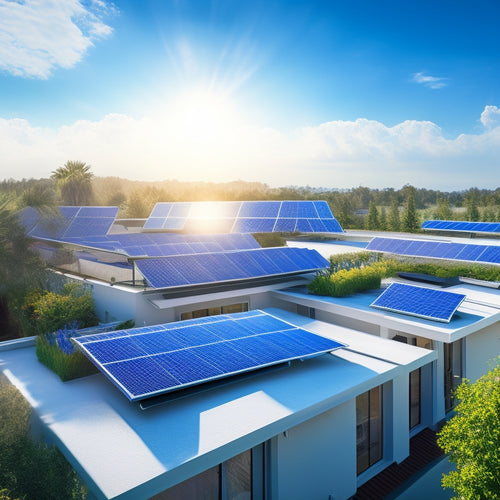
What Factors Should You Consider in Solar System Maintenance Cost
Share
When calculating the total cost of ownership for your solar system, you'll need to take into account several key factors that impact maintenance costs. The age and condition of your system, as well as the type and quality of your panels, greatly influence maintenance needs and expenses. You'll also need to factor in inverter replacement frequency, cleaning and inspection costs, and energy storage maintenance expenses. Additionally, factors like panel durability, weather resistance, and warranty coverage can affect your overall maintenance budget. By understanding these factors, you'll be better equipped to anticipate and plan for maintenance costs, and uncover more about optimizing your solar system's performance and longevity.
Key Takeaways
- System age and condition significantly impact maintenance costs, with older systems requiring more frequent maintenance and being more prone to faults.
- The type and quality of solar panels influence maintenance costs, with high-efficiency panels requiring less maintenance and lower-efficiency panels needing more frequent cleaning.
- Inverter replacement frequency affects maintenance budgeting, with regular monitoring essential for identifying issues before they escalate and impacting energy output.
- Cleaning and inspection costs depend on location, climate, and panel type, with labor and equipment costs influencing overall maintenance expenses.
- Energy storage system maintenance is crucial for optimal performance, involving regular performance monitoring, periodic inspections, and software updates to extend battery lifespan.
System Age and Condition
As the solar system ages, its condition greatly impacts maintenance costs. You'll notice that as your system gets older, its performance starts to decline. This decline in system performance directly affects maintenance frequency.
For instance, a well-maintained system may only require annual or bi-annual check-ups, but a system that's been neglected may need more frequent visits from a technician.
Moreover, an aging system is more prone to faults and failures, which can lead to costly repairs. You may need to replace worn-out parts or even entire components, adding to the overall maintenance cost.
Additionally, as the system's condition worsens, it may start to underperform, reducing the amount of energy it generates. This reduction in energy output can lead to increased electricity bills, further straining your wallet.
To avoid these added expenses, it's essential to prioritize regular maintenance and monitoring of your solar system's condition. By doing so, you can identify potential issues early on and address them before they escalate into costly problems.
Type and Quality of Panels
Determine the type and quality of panels installed in your solar system, as this factor greatly influences maintenance costs. High-efficiency panels, for instance, may require less maintenance due to their advanced technology and build quality.
On the other hand, lower-efficiency panels might need more frequent cleaning and inspections to guarantee peak performance.
It's essential to review your panel warranty coverage, as it can greatly impact your maintenance expenses. A thorough warranty can provide protection against defects, repairs, and even replacements, reducing your financial burden.
Look for manufacturers that offer extended warranties (25 years or more) and extensive coverage, including parts and labor.
When evaluating panel quality, consider factors such as durability, weather resistance, and certifications (e.g., UL or IEC).
Reputable manufacturers often provide detailed specifications and performance data, allowing you to make informed decisions.
Inverter Replacement Frequency
Your solar system's inverter is the unsung hero, converting DC power from the panels into usable AC electricity for your home. As a critical component, it's important to evaluate its replacement frequency when calculating your solar system maintenance cost.
Typically, inverters last between 10 to 15 years, depending on the manufacturer and quality. You'll want to factor in the cost of replacement within this timeframe.
Check your inverter's warranty coverage, as some manufacturers offer extended warranties or guaranteed performance levels. This can help mitigate replacement costs.
Additionally, be aware of performance degradation over time. As your inverter ages, its efficiency may decrease, leading to reduced energy output. Regular monitoring can help identify potential issues before they become major problems.
When budgeting for inverter replacement, think about the cost of the new unit, labor, and any necessary upgrades to your system.
Cleaning and Inspection Costs
Dust, debris, and environmental factors can hinder your solar panels' performance, reducing energy output and overall system efficiency. To maintain peak performance, you'll need to take into account cleaning and inspection costs.
Regular cleaning is essential to remove dirt, dust, and other obstructions that can reduce energy output. You can choose from various cleaning techniques, including manual brushing, water-based cleaning, and robotic cleaning systems.
The frequency of cleaning will depend on your location, climate, and the type of solar panels you have.
Here are some factors to evaluate when calculating cleaning and inspection costs:
- Cleaning frequency: How often you need to clean your solar panels, based on the environmental conditions and panel type.
- Cleaning techniques: The method you choose to clean your panels, which can impact the cost and effectiveness of the cleaning process.
- Inspection frequency: How often you need to inspect your solar panels to identify potential issues and perform maintenance tasks.
- Labor costs: The cost of hiring professionals to clean and inspect your solar panels, if you don't plan to do it yourself.
- Equipment and material costs: The cost of cleaning solutions, brushes, and other equipment needed for the cleaning process.
Energy Storage Maintenance
In conjunction with your solar panels, energy storage systems like batteries require regular maintenance to uphold peak performance and extend their lifespan.
As you consider your solar system maintenance cost, it's vital to factor in the costs associated with energy storage maintenance.
Regular performance monitoring is fundamental to identify any potential issues before they affect your energy storage system's overall performance. You should expect to pay for periodic inspections, which may include checking the battery's state of charge, voltage, and temperature.
Additionally, you may need to pay for software updates to guarantee your energy storage system remains compatible with your solar panel system.
Proper maintenance can greatly impact your battery lifespan, which can range from 5 to 15 years, depending on the type and quality of your energy storage system.
By investing in regular maintenance, you can help extend the lifespan of your batteries and optimize their performance.
When calculating your solar system maintenance cost, be sure to include the costs associated with energy storage maintenance to guarantee you're getting the most out of your investment.
Frequently Asked Questions
How Often Should I Check My System's Electrical Connections?
You should perform electrical inspections every 6-12 months to guarantee connection safety, checking for signs of wear, corrosion, or overheating, and addressing any issues promptly to prevent system failures and maximize energy output.
Can I Perform Maintenance Tasks Myself or Hire a Professional?
As you weigh DIY maintenance against professional services, consider your comfort level with electrical work and the system's complexity; if you're not confident, hiring a pro can guarantee safety and optimize performance, giving you peace of mind and maximizing your investment.
Are There Any Government Incentives for Solar System Maintenance?
You'll be happy to know that, yes, there are government incentives for solar system maintenance, including tax credits and maintenance rebates, which can greatly reduce your overall costs, making your eco-friendly choice even more financially appealing.
How Do I Determine the Optimal System Size for My Property?
Like a puzzle piece, your solar system's ideal size falls into place when you consider your energy needs and roof size. Calculate your system capacity by evaluating your energy efficiency, and you'll reveal the perfect fit for your property's unique requirements.
What Is the Average Lifespan of a Solar System?
You're looking at a solar system lifespan of around 25-30 years, with solar panels degrading at a rate of 0.5-1% per year, and inverters lasting around 10-15 years, requiring replacement to maintain peak energy production.
Conclusion
As you gaze up at your solar system, remember that maintenance costs are lurking in the shadows, waiting to pounce. Don't let them catch you off guard. By considering the system's age and condition, panel quality, inverter replacement frequency, cleaning and inspection costs, and energy storage maintenance, you'll be prepared for the financial realities that come with utilizing the sun's power.
Related Posts
-

What You Need to Know About RV Solar Maintenance
When you're out on the road, your RV's solar panel system is your lifeline. But without regular maintenance, you're l...
-

Why Cities Need Smart Charging Infrastructure Now
You're about to experience a tidal wave of electric vehicles hitting your city's streets, and it's essential you're p...
-

Best Solar Panel Options for Maximum Energy Savings
You can maximize your energy savings with solar panels that boast efficiency ratings above 20%, paired with extensive...


